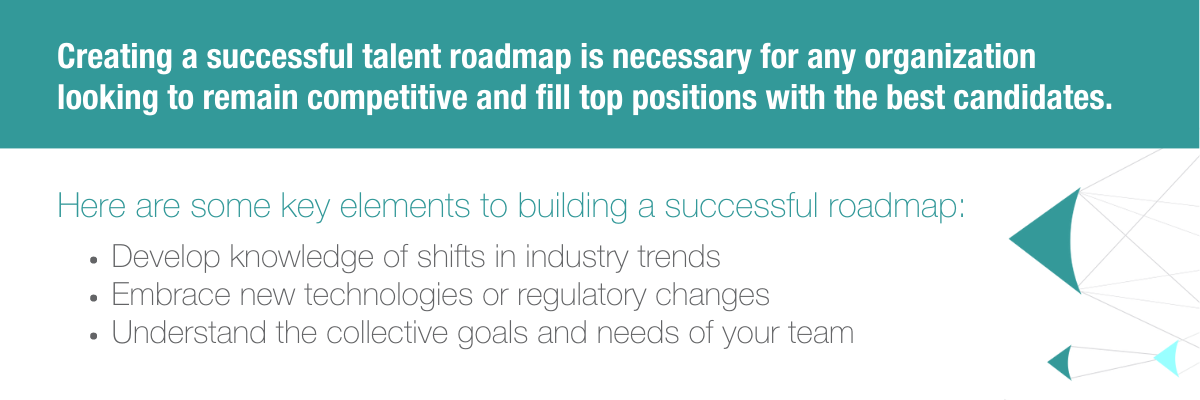Why Your Talent Roadmap Needs Recruiting & Workforce Planning

Attracting and retaining top talent is essential for the growth and sustainability of any organization. A company’s recruitment and workforce planning strategies are pivotal in achieving this objective. To effectively address these challenges, it is vital to have a comprehensive recruiting and workforce planning section in a talent roadmap.
Companies with a strong recruiting and workforce planning strategy can enhance their understanding of their organization’s current and future needs, including identifying potential gaps in skills and knowledge.
An effective recruitment strategy can also help ensure diversity and inclusion when implementing hiring practices. Utilizing the strategies identified in this blog can help achieve organizational goals, minimize risks associated with inadequate staffing, and leverage existing skill sets and employee capabilities. Let’s get started!
Don’t Get Left Behind. Get Your Free Guides.
The Ultimate Guide to Workforce Planning 2023
Crafting a Talent Acquisition Roadmap: A Practical Guide to Recruitment Frameworks
Evaluating the Current Workforce for Potential Gaps in Skills or Knowledge
When building a talent roadmap, one of the most important steps is to evaluate the current workforce for potential gaps in skills or knowledge. This process helps organizations identify any deficiencies or areas that need improvement that can be addressed through new hires, training and development opportunities, or other strategies. Additionally, it allows companies to anticipate future skills needs and plan accordingly for long-term success.
This is more important than ever as the majority of job seekers and employees list career advancement and learning opportunities as one of their top priorities.
Evaluating the current workforce for potential gaps in skills or knowledge is beneficial for various reasons. First, it allows organizations to better align their resources with their business goals and objectives by ensuring they hire individuals with the necessary skill sets to support those objectives. Furthermore, evaluating existing employees ’ skill sets can facilitate succession planning and create a more seamless transition when roles change or become vacant due to retirement or other reasons.
Additionally, evaluating the current workforce can help organizations identify areas where employees may benefit from additional training and development opportunities. By providing employees with learning opportunities that align with their personal growth goals, companies can ensure they retain top talent while helping them stay competitive in an ever-changing job market.
Tech Stack & Your Staff
Assessing existing staff members’ competencies can be helpful when deciding how best to leverage technology tools such as automation and artificial intelligence (AI) to improve operations in an increasingly digital world.
Organizations should evaluate the areas of their workforce where current personnel may lack skill or knowledge and use that data to prioritize technology investments so they can confidently make decisions. Having the right tools, trained staff, and the ability to adapt to disruption quickly can be the critical difference between driving real value from technology and struggling with ROI. Investing in a digital workplace can open up numerous opportunities, but doing your due diligence upfront is essential.
Overall, evaluating the current workforce for potential gaps in skills or knowledge is essential when building a talent roadmap. This enables companies to proactively address deficiencies within their teams while simultaneously creating plans for future success based on anticipated trends inside and outside the organization itself.
Building Strategies to Recruit and Retain the Right Employees for Future Successes
It’s estimated that 97 million new jobs will be created by 2023, which presents a significant opportunity. When building a talent roadmap for future success, it is essential to build strategies to recruit and retain the right employees. A successful talent roadmap will help an organization understand its workforce needs now and in the future. It also provides a strategy for filling those roles with the most qualified people who share the same values and have the skills needed for long-term success.
Recruiting and retaining the right employees can be incredibly beneficial to an organization’s future success. By clearly understanding what type of people you need to fill specific roles and building strategies around hiring them, you will reduce turnover rates, increase employee engagement and morale, and ensure that your business has the necessary skillsets in place for long-term growth and profitability.

Ensure you have a complete view of potential candidates for each role – don’t limit yourself to traditional recruitment methods like geotargeting or other tactics to reach ideal hires.
Building strategies to recruit and retain the right employees is key when creating a talent roadmap. By putting these efforts at the forefront of your organization’s plans, you can ensure that you have access to qualified personnel with the necessary skillsets while staying competitive in an ever-changing business environment.
Drive a competitive and effective strategy for finding and hiring top talent with this guide: Crafting a Talent Acquisition Roadmap: A Practical Guide to Recruitment Frameworks
Implementing Policies to Ensure Diversity and Inclusion in Hiring Practices
Implementing policies that ensure diversity and inclusion in hiring practices is increasingly important when building a talent roadmap. Diversity and inclusion are essential components of any profitable, successful business, as they help create an environment of innovation and collaboration. Companies can better recognize and address their customer’s needs and develop better products or services with a diverse workforce. A diverse team brings different perspectives and helps uncover problems that a homogenous group may have overlooked.
Looking to Hire Qualified Diverse Candidates?
Read: How to Achieve a Diverse Workforce Through Recruitment
For this reason, it is essential to ensure that recruitment practices are equitable across all groups regardless of gender, race, ethnicity, nationality, or sexual orientation. This means:
- considering candidates from underrepresented backgrounds
- advocating for ESGs within your organization
- assessing your hiring practices to see where you can eliminate hurdles for underrepresented groups
- evaluating the demographic makeup of the local area when crafting job postings

These efforts will prove beneficial in the long run by creating a workplace where everyone is respected and included regardless of background or identity. Creating an inclusive workplace can provide companies access to previously inaccessible talent pools due to unconscious bias or exclusionary practices. A more diverse workforce also increases team morale, leading to increased productivity – meaning fewer costs from employee turnover – resulting in improved overall business performance.
Leveraging Technology to Streamline Recruiting Processes
A recent survey showed that 34% of companies plan to expand their workforce due to technology integration. Therefore, leveraging technology to streamline recruiting processes is essential to any organization’s talent roadmap. Automation and artificial intelligence (AI) solutions can provide tremendous value for organizations looking to optimize recruitment efforts. AI-supported technologies such as applicant tracking systems (ATS) can provide deep insights into the candidate experience, enabling recruiters to identify ideal candidates and reduce time-to-fill quickly. Additionally, assessments can evaluate candidates’ skills and aptitudes, ensuring that organizations hire the most qualified applicants.
Want more qualified candidates fast? This guide explores the crucial steps leaders of recruitment teams need to make to drive a competitive and effective strategy for finding and hiring top talent. Learn more.
CRM systems provide a comprehensive overview of the recruitment process, allowing recruiters to focus on engaging with qualified candidates and building relationships with them. This helps them nurture qualified leads until they become applicants. Additionally, modern HRIS platforms provide real-time visibility into hiring data to help recruiters adjust their strategies to improve overall efficiency in screening and selection processes.
Read Now: Evaluating Recruiting Technologies: 10 Features to Consider Before You Buy
Technology also facilitates communication and collaboration between teams during recruitment by leveraging cloud-based tools such as video conferencing or mobile communications platforms. This simplifies workflows while providing a secure information-sharing platform throughout the recruitment, from sourcing to onboarding new hires.
By building an effective recruiting tech stack with these future-focused solutions, organizations will benefit from greater accuracy when evaluating candidates and improved time-to-hire metrics critical for successful Talent Acquisition initiatives.
Recognizing the value of a strong recruiting and workforce planning approach in any successful talent roadmap is essential. By identifying current capabilities and resources, staying aware of potential risks, and being proactive in preparing for future objectives, organizations can ensure their success in the present and future. It’s never too early to start building your roadmap—start today by taking the opportunities at hand and implementing them into an overall plan. With these strategies in mind, your organization will be well-positioned to overcome any hurdles on the journey to success confidently.
Undoubtedly, having a roadmap to guide you makes all the difference regarding workforce planning and recruitment. We hope this blog post has been informative and helpful in guiding your talent strategy journey. For more tips and tricks on developing a robust talent strategy for your organization, follow Recruiter.com on LinkedIn.
Don’t Get Left Behind. Get Your Free Guides.
The Ultimate Guide to Workforce Planning 2023
Crafting a Talent Acquisition Roadmap: A Practical Guide to Recruitment Frameworks

